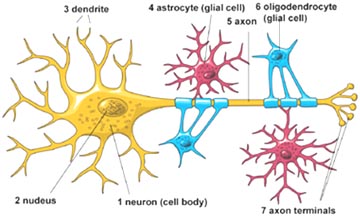Cell Targets
Overview
The toxic process in ALS may not be taking place solely in the neurons. The mutant protein, copper-zinc superoxide dismutase (SOD1) (see section on SOD1), is linked to some cases of the disease. If mutant SOD1 is present in motor neurons, but normal SOD1 is in the surrounding, protective glia cells, then the motor neurons do not die. Hints from the mutant SOD1 mice, and ALS patients suggested that something else other than motor neurons are affected in the disease. Experiments only possible with modern genetic techniques, with mice that selectively make mutant SOD1 in particular cells of the nervous system, have now confirmed that the neighborhood surrounding motor neurons matters. ALSA is funding research that will clarify which tissues are critical to the cause, progress, and the desired cell targets for treatment of the disease.
Which Cells are Crucial in ALS?
Motor neurons have long been the focus for scientists trying to solve the problems in ALS. The obvious symptoms of this disease involve weakness of muscles. Damage to the nerves supplying muscles is also evident in ALS.

Nerves consist of the long fibers coming out of motor neurons, bundled together. The cell bodies of these motor neurons reside in the spinal cord. Here they are surrounded, nurtured, and protected by a variety of cells called glia. Support of motor neurons is especially critical, as their metabolic demands are extraordinary. The cell bodies are only visible through a microscope, yet their fibers, called axons, have to travel a meter or more to reach muscles in the fingers and toes.
Glia help the motor neurons maintain appropriate metabolic functions and provide adequate supplies at the nerve endings. The glial cells buffer neurons against drastic changes in the concentration of transmitter molecules, by instantly sweeping up excess. Some types of glia also serve as immune mediators in the nervous system (see section on Inflammation and ALS). Attention in ALS research is now focusing on the key role that glia play in the death of motor neurons.
Types of Glia
Glial cells include the astrocytes, which sweep up excess transmitter molecules. Astrocytes also supply neurons with the supporting small molecules that promote growth and repair, called trophic factors (see section on trophic factors). By influencing trophic factors, researchers hope to boost the survival of motor neurons affected by ALS.
Microglia are the resident immune cells of the nervous system. These relatively small sized glia are activated early in the process of ALS, presumably reacting to the damage, but perhaps instigating it as well. They emit immune modulators that are meant to be protective but can be damaging in excess.
Another glial cell is the oligodendrocyte, which create myelin by wrapping around the axon from each motor neuron. Myelin serves as insulation. The structure of the myelin sheath that the oligodendrocytes create optimizes rapid signals that get muscles to contract.
Some neurodegenerative diseases directly attack the oligodendrocytes. Myelin is damaged in multiple sclerosis, and in stroke and traumatic injury to the nervous system. The role of the oligodendrocytes in ALS is unclear. But activating these cells might aid stem cell therapies that attempt to replace or repair dying motor neurons.
The Neighborhood Effect in ALS
Motor neurons that express the mutant SOD1, associated with some inherited ALS, will survive provided that they are surrounded by a certain proportion of glia with normal SOD1, mouse experiments show. That the neighborhood matters to the fate of motor neurons, lends hope for treatment of ALS. It might be sufficient to implant, by gene or stem cell therapy, a minimum number of cells that do not have any mutant protein but instead make helpful factors.
An obvious consequence of ALS is that muscles waste away. The motor neurons serving the muscles are dying. Researchers know that muscle wasting follows when nerves are severed. But does the muscle merely suffer the end result of the disease in ALS, or does it play an active role, even, perhaps, starting the destruction? New research is seeking an answer to the as yet undetermined part that muscle tissue plays in ALS.
Recursos en español disponibles. Por favor llame al (212) 619-1400. Gracias.
42 Broadway, Suite 1724, New York, NY 10004 | (212) 619-1400
©2019 The ALS Association Greater New York Chapter. All rights reserved.
DONATE